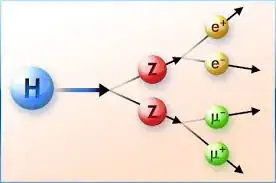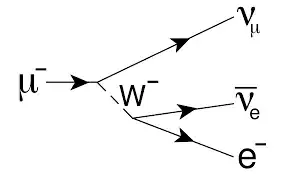Consider (for example) the next particle decays:
The decay of a Higgs and the decay of a muon [in the diagram of which we also see the decay of (virtual) $W^-$ into an electron and its associated neutrino)].
If a particle (or an excitation of the associated quantum field) is truly elementary doesn't that imply that it can't change into other particles?
The case of a muon (which is considered elementary, i.e. not built up out of other particles) changing into an electron, and two neutrinos (which are all three also considered to be elementary) can very easily be described in the Rishon Model of Haim Harari (of which I'm a big fan), in which only two (!) truly elementary (apart from the photon, gluon and the $Z^0$ and $W^{+/-}$, of which the last three are considered to be composed particles which transmit not a truly elementary force, but a residual force of a deeper force, as once the $\eta$ was thought to be the transmitter of the strong force, which turned out to be the residual force of the strong force as it is known today) particles are said to exist: the T- and V-rishon (and their anti-particles).
$\bar T\bar T\bar T$ (the muon, in this model considered as an excited state of the electron) gives a $VVV$ (neutrino), $\bar V\bar V\bar V$ (the anti-neutrino, associated with the electron), and a $\bar T\bar T\bar T$ (the electron). So before and after the change, the same (net) combination of rishons exists.
The virtual $W^-$ is a short existent $\bar V\bar V\bar V\bar T\bar T\bar T$ combination, which in the rishon model obviously has an electric charge -1 because the $T$-rishon has electric charge +1, and the $V$-rishon has no electric charge. In this change, the (according to the rishon model) truly elementary particles keep their identity, so a $T$-rishon can't change into a $V$-rishon and vice-versa, and it only seems that what we consider elementary particles can change into other elementary particles.
The decays, in the rishon model, are nothing more than rearrangements of T-rishons and V-rishons (and their antiparticles), while at the same time virtual $T$ and $V$ rishons can become real in the decay and contribute to the process. Clearly, these $T$ and $V$ rishons can't change their identity if they are truly elementary (if so that would indicate that these two elementary particles would be composed of even more elementary particles, which is nonsense if you need only two elementary particles to explain the abundance of quarks and leptons; the model doesn't address the force-carrying particles, which are all massless in this model).
In the case of the changing Higgs (which in the rishon model isn't needed to give mass to particles, but it nevertheless exists because it has been detected so it can be considered as a boson particle), the change results in two pairs of $TTT$ and $\bar T\bar T\bar T$ combinations of T-rishons (and their anti-particles), the electron and it's anti-particle and a muon together with its anti-particle. The two $Z^0$ particles that appear shortly are both $TTT\bar T\bar T\bar T$ combinations (with obvious electric charges of zero). So the Higgs can be a combination of six $T$-rishons and six $\bar T$-rishons. Again the truly elementary particles (the $T$ and the $V$) don't change their identity.
So does the fact that what we consider as elementary particles (excitations of the associated field) can change into other particles mean they are not truly elementary?

